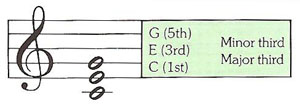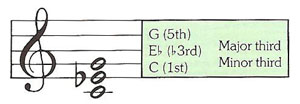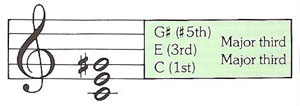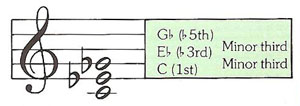triad

C major triad.

C minor triad.

C augmented triad.

C diminished triad.
A triad is a three-note chord consisting of a root (the name by which the tonic is known when referring to a chord), a third, and a fifth. This means that a triad has two intervals, each of a third. All triads are three-note chords, but not all three-note chords are triads.
In the harmonic series of any note, the tonic is the fundamental, and the octave, the fifth, and the third are the most prominent overtones. These are the notes that make up the triad, and it's the reinforcement given by the third and fifth that gives the triad its strength and stability.
Varieties of triad
There are four kinds of triad – major, minor, augmented, and diminished. Although the intervals that make up the triad are always thirds, they differ in that they can be either major or minor thirds. The various triads can also occur in a different vertical order as inversions.
Major and minor triads both span an interval of a perfect fifth from the root. It's the interval from the root to the middle note of the group (the third) that determines whether they are major or minor. A major triad with a sharpened fifth is called augmented, and a minor triad with a flattened fifth is called diminished.
So to summarize: A major triad is a triad containing a major third. A minor triad is a triad containing a minor third. An augmented triad is a triad with an augmented fifth. A diminished triad is a triad with a diminished fifth (see the accompanying diagrams).
Tonic and dominant triads
A tonic triad is built on the tonic of the scale and is represented by the Roman numeral I if major and i if minor. A dominant triad is built on the dominant of the scale and is represented by V. The notes of a dominant triad are the dominant (the root), the leading note of the scale (the second note of the chord), and the supertonic (the third note of the chord). All dominant chords must be major (in order to have a leading note present). So if the dominant chord is in a minor key, the middle note must be raised a semitone in order to make the chord major.
Origin of the triad
The theory of triads dates back to the middle of the 15th century, when the diatonic major/minor tonal system was evolving. Before then, the horizontal effect of the intervals of the various modes had established the tonic note and the fifth note of a scale as the most important. The triad was created when the third was combined with the first and fifth to produce a vertical chord.


